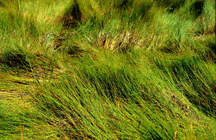Every now and then, there is good news in the fight against invasive species. Recently, I received an email including this: “Good news -- I am very happy to report that we have successfully covered all the known patches of Spartina on Cox Island this year as promised.
This is good news – I’m crossing my fingers in the hopes that we’re getting closer to solving a major problem, but I’m not breaking out the champagne just yet. Here is the rest of the story.
About 1940, saltmarsh cordgrass (Spartina patens) was introduced to Cox Island in the Siuslaw estuary. For decades, no one paid any attention to this East coast native. Then in the 1990s, people began to notice that other non-native saltmarsh cordgrass species were becoming invasive on the West Coast. Natural mud flats in California and Washington were being converted to saltmarsh meadows. Shorebirds and crustaceans that depend on mud flats were declining.
In 2003, experts at Portland State University (PSU) developed an Oregon Spartina Response Plan to keep Oregon free of invasive saltmarsh cordgrasses. Four species of cordgrasses were recognized as A-rated weeds (highest priority for exclusion/eradication), including S. patens. In the years since, small infestations have been found and eradicated by the Oregon Department of Agriuculture (ODA) and PSU cooperators in Youngs Bay, Coos Bay, and near the mouth of the Siuslaw River. The S. patens infestation on Cox Island was the sole blot on an otherwise perfect record.
Cox Island posed a conundrum for ODA and the State Weed Board. The Nature Conservancy (TNC) owns Cox Island, and the preserve manager refused to allow herbicides to be used on the property. Instead, she offered to cover the cordgrass patches with black plastic landscape fabric. Over a several year period, progress in killing the saltmarsh cordgrass was slow, and the cost was high. TNC applied for lottery-funded grants (Oregon Watershed Enhancement Board(OWEB)/State Weed Board) to cover the cost. The State Weed Board struggled with the desire to see the job carried through to the end while being good stewards of public funds. Is it right to use public funds on a non-chemical noxious weed eradication project, if the same result could be obtained quicker, more reliably, and for less money with herbicides?
One could argue that herbicides have negative environmental impacts that should be considered. True, though modern formulations are more specific and less persistent in the environment than older products, and black plastic isn’t exactly environmentally benign. I’d bet that spot spraying with Imazapyr kills fewer non-target organisms over a shorter time than covering patches of ground with black plastic for a year. In the end the State Weed Board withdrew their support for the plastic covering process. TNC still refused to use herbicides, found other funding, and continued with the plastic.
Even folks that are not fans of herbicides should understand that eradicating an invasive species before it spreads all over the place preserves environmental health and reduces the need for future control. Like your grandmother told you, an ounce of prevention is worth a pound of cure.
Cross your fingers that the black plastic works and Oregon will soon be free of mature seed-producing saltmarsh cordgrass. The next challenge will be to stay vigilant until the seed bank on Cox Island is exhausted. That could take years. The really good news will come when there are no more seedlings coming up -- that’s when we should break out the champagne!
Dan Hilburn


No comments:
Post a Comment